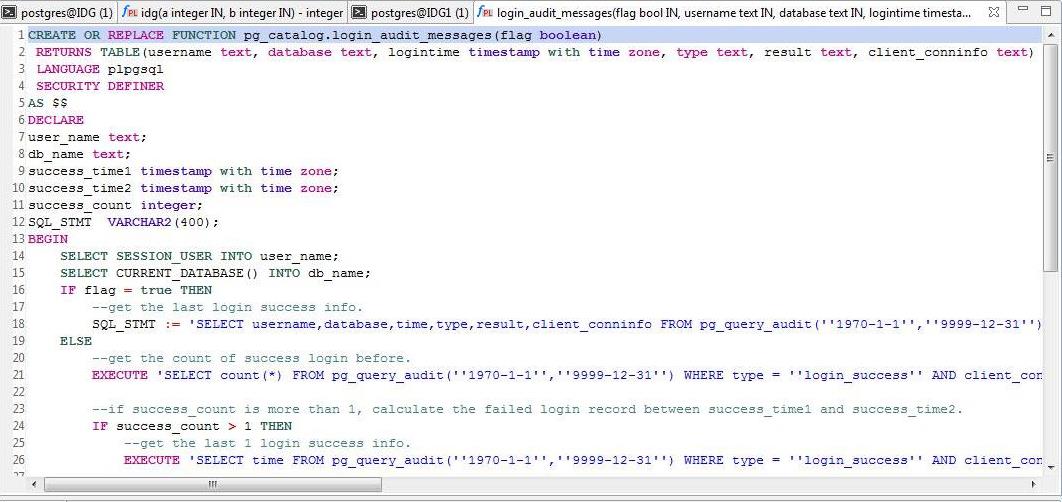Formatting of SQL Queries¶
Data Studio supports formatting and highlighting of SQL queries and PL/SQL statements.
PL/SQL Formatting¶
Follow the steps to format PL/SQL statements:
Select the PL/SQL statements to be formatted.
Click
 on the toolbar to format the query.
on the toolbar to format the query.Alternatively, use the key combination Ctrl+Shift+F or choose Edit > Format from the main menu.
The PL/SQL statements are formatted.
SQL Formatting¶
Data Studio supports formatting of simple SQL SELECT, INSERT, UPDATE, DELETE statements which are syntactically correct. The following are some of the statements for which formatting is supported:
The SELECT statement must be made of the following clauses:
Target list
FROM clause (including JOIN)
Where
Group by
Having
Order by
Common table expression
SELECT statement without SET operations like UNION, UNION ALL, MINUS, INTERSECT and so on
SELECT statements without sub-queries
The INSERT statement is made of the following clauses only:
Insert Into Table name
Values
Values Column List
RETURNING
The UPDATE statement is made of the following clauses only:
Update Table name
SET
FROM clause (including JOIN)
Where
RETURNING
The DELETE statement is made of the following clauses only:
Delete From Table name
USING clause (including JOIN)
Where
RETURNING
Follow the steps below to format SQL queries:
Select the SQL query statements to be formatted.
Click
 on the toolbar to format the query.
on the toolbar to format the query.Alternatively, use the key combination Ctrl+Shift+F or choose Edit > Format from the main menu.
The query is formatted.
The following table describes the query formatting rules.
Table 1 Query formatting rules¶ Statement
Clause
Formatting Rule
SELECT
SELECT list
Line break before first column
Indent column list
FROM
Line break before FROM
Line break after FROM
Indent FROM list
Stack FROM list
Line break before JOIN
Line break after JOIN
Line break after JOIN
Line break before ON
Line break after ON
Indent table after JOIN
Indent ON condition
WHERE
Line break before WHERE
Line break after WHERE
Place WHERE condition on single line
Place WHERE condition on single line
GROUP BY
Line break before GROUP
Line break before GROUP BY expression
Indent column list
Stack column list
HAVING
Line break before HAVING
Line break after HAVING
Indent HAVING condition
ORDER BY
Line break before ORDER
Line break after BY
Indent column list
Stack column list
CTE
Indent subquery braces
Each CTE in a new line
INSERT
INSERT INFO
Line break before opening brace
Line break after opening brace
Line break before closing brace
Indent column list brace
Indent column list
Line break before VALUES
Stack column list
Line break before VALUES
Line break before opening brace
Line break after opening brace
Line break before closing brace
Indent VALUES expressions list braces
Indent VALUES expressions list
Stack VALUES expressions list
DEFAULT
Line break before DEFAULT
Indent DEFAULT keyword
CTE
Each CTE in a new line
RETURNING
Line break before RETURNING
Line break after RETURNING
Indent RETURNING column list
Place RETURNING column List on single line
UPDATE
UPDATE Table
Line break before table
Indent table
SET Clause
Line break before SET
Indent column assignments list
Indent column assignments list
FROM CLAUSE
Line break before FROM
Line break after FROM
Indent FROM list
Stack FROM list
JOIN CLAUSE(FROM CLAUSE)
Line break before JOIN
Line break after JOIN
Line break before ON
Line break after ON
Indent table after JOIN
Indent ON condition
WHERE CLAUSE
Line break before WHERE
Line break after WHERE
Place WHERE condition on single line
Place WHERE condition on single line
CTE
Each CTE in a new line
RETURNING
Line break before RETURNING
Line break after RETURNING
DELETE
USING CLAUSE
Indent RETURNING column list
Line break before FROM
Line break after FROM
Indent USING list
Stack FROM list
JOIN CLAUSE
Line break before JOIN
Line break after JOIN
Line break before ON
Line break after ON
Indent table after JOIN
Indent ON condition List
WHERE CLAUSE
Line break before WHERE
Line break after WHERE
Place WHERE condition on single line
Stack WHERE condition list
CTE
Each CTE in a new line
RETURNING
Line break before RETURNING
Line break after RETURNING
Indent RETURNING column list
Data Studio supports automatic highlighting of the following punctuation mark's pair when cursor is placed before or after the punctuation mark or the punctuation mark is selected.
Brackets - ( )
Square brackets - [ ]
Braces - { }
Single-quoted string literals - ' '
Double-quoted string literals - " "
Follow the steps below to change case for SQL queries and PL/SQL statements:
Method 1
Select the text, and choose Edit > Upper Case/Lower Case.
The text changes to the case selected.
Method 2:
Select the text, and choose
 or
or  from the toolbar.
from the toolbar.The text changes to the case selected.
Method 3:
Select the text, and press Ctrl+Shift+U to change to the upper case or Ctrl+Shift+L to change to the lower case.
The text changes to the case selected.
SQL Highlighting¶
Keywords are highlighted automatically when you enter them (according to the default color scheme) as shown below:

The following figure shows the default color scheme for the specified type of syntax:

You can also customize SQL highlighting schemes for specific types of syntax. For details, see Syntax Coloring.